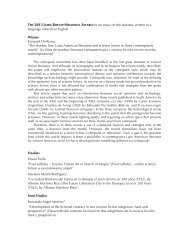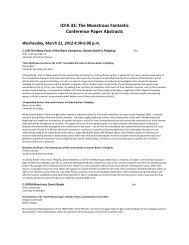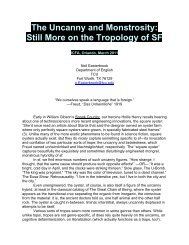<strong>Monstrous</strong> SacrificesJason HarrisFlorida Institute of Technology“<strong>The</strong>re is no society in which cannibalism does not prey upon the mind as a phobia.” It is a truism for cultural critics that monsters areprojections of the human psyche. One connection between the monster within and the monster without is the tale of monstrous sacrifices.Whether it is the monster itself that is scapegoated as social excresence to be slain or the victim that is sacrificed, ritual sacrifices involvingmonstrosity entail a public text that emblazons the essential violence of human civilization. Rather than the patrolling legendary beast offolklore that is an intensified shadow of the wilderness distorted into a shape of fear that prowls along the metaphysical contact zone betweenthe civilized and the uncivilized, and may be avoided, the monster that demands sacrifices is born from the hearts and brains of humanity, thedark recesses of the human mind and the equally dark corridors of churches and palaces, and there is no fleeing this darkness.Not only in mythic renderings, such as the sacrifices to the Minotaur or of Andromeda to Cetus, but also in folktales of the Wendigo where onepossessed by that cannibalistic spirit must be slain for the tribe to prosper, and in those horror stories such as Sydney Bounds’s “Down-HomeMarket,” where an annual sacrifice to a hungry monster ensures prosperity for the local trader, or Shirley Jackson’s “<strong>The</strong> Lottery” where thecommunity itself is its own monster, the socio-economic message is clear: civilization makes ugly sacrifices. Modern horror stories, from H.P.Lovecraft and his circle (Derleth, Bloch, etc.) to Thomas Ligotti, often use monsters to reveal a universe untethered to an anthro-sympatheticdeity. Through monstrous sacrifices, the literal destruction of the human body by the monstrous body underscores the chaotic patterns of thecosmos while emphasizing the inherent violence in human civilization.Blind as a Vampire Bat: Tanya Huff’s Blood Books as Discourse on Monstrosity as a Symbol of DisabilityDerek Newman-StilleTrent UniversityContemporary ‘dark’ fantasy author Tanya Huff portrays traditional disability subject matter inscribed onto the extremified abjected other - themonstrous - in her Blood Books series. Huff situates her protagonist, Vicki, a detective who has a degenerative eye disease that has resulted inthe loss of her night vision and resultant dismissal from the police force, in direct contact with Henry, a vampire who aids her in conductingdetective work. Vicki, a person who is only able to see the world during the day, is paired with a creature of the night, unable to be awake orinteract with anyone during the day. <strong>The</strong> two characters experience the world in seemingly direct contrast to one another: one unable to see atnight, and the other unable to live during the day. Both characters are disabled in their own way, but compensate and help the other toaccommodate to inaccessible environments: Vicki relying on Henry’s vision in low-lit locations, and Henry relying on Vicki to get him to a safespace during the day. Huff contrasts the monstrous senses (abundance) to the disabled senses (perceived as deficit) in her two main characters,creating a dialectic narrative between disability and monstrosity issues. Like many disability narratives, Huff’s novels represent a criticaldiscourse around the concept of loss: of vision, job, humanity, daylight, and ‘normalcy’. <strong>The</strong> juxtaposition and interplay between the monstrousvision of the vampire and the deteriorating vision of the woman allows for a rich metaphorical exploration of blindness as a social symbol. Sightand vision become personifications of loss, alterity, darkness, morality, and constricted viewpoint. Vicki’s glasses become a lens through whichshe can see the world as it really is, rather than the appearances that shape the experience of everyone who does not believe in the monstrous.Ironically, her night-blindness lets her see the ‘things that go bump in the night’. Her literal narrowing of vision actually allows her ametaphorical expansion of vision outside of the confines of ‘normal’ world view and her alterity, her embodied difference, allows her to bemore receptive to the abnormal.109. (CYA) Children’s Fantasy in Its Historical Context Captiva AChair: Rebekah FitzsimmonsUniversity of Florida<strong>The</strong> Real vs. <strong>The</strong> <strong>Fantastic</strong>: <strong>The</strong> Fight for Early Children’s FantasyMike LevyUniversity of Wisconsin-StoutI'm currently engaged in writing a history of children's fantasy for Cambridge UP and I'd like to read a paper based on the first chapter of thebook. <strong>The</strong> paper will be called <strong>The</strong> Real vs. the <strong>Fantastic</strong>: the Fight for Early Children's Fantasy. In the paper I will discuss the history of thecreation of children's fantasy, beginning with some of the reasons why fantasy literature was looked down upon in the middle ages and wellinto the 19th century. I will cover a number of classic early works of the fantastic as they relate to children's literatue, most notably Reynardthe Fox, the Nine Champions of Christiandom, Beauty and the Beast and Gulliver's Travels, discussing ways in which they are and aren'tchildren's literature and also the reactions of various contemporary theorists to these works, including John Locke, David Hume, Sarah Timmerand others. I will also discuss the ways in which such works reveal interesting information about class and gender attitudes at the times thatthey were written.<strong>The</strong> Chaos Monster and the British Empire: <strong>The</strong> Subaltern in H.E. Marshall’s Work for ChildrenJanice HawesSouth Carolina State UniversityA popular Edwardian author whose works are still readily available online, H. E. Marshall earned a reputation as the “historiographer royal forchildren,” as one reviewer in the November 7, 1908 issue of <strong>The</strong> Journal of Education notes. Particularly popular, even today, are Marshall’sOur Empire Story (1908) and Stories of Beowulf: Told to the Children (1908). Marshall’s 1908 publications were meant in part to support theimperialist cause of Great Britain by emphasizing a chivalric code as rendered through a British imperialist lens. In Marshall’s version of history,those trusted with the role of securing British India follow the ancient chivalric code she associates with heroes such as Beowulf, while those
who challenge the order that the British wish to establish in this part of “Greater Britain” are both human heathens opposing chivalric virtuesand demons attempting to bring darkness and chaos to the land. This paper proposes to explore how Marshall’s depictions of the Beowulfmonsters compare and contrast with her depictions of the subaltern in British India. Although Marshall’s discourse appears to rely on thedichotomies of knightly vs. monstrous and good vs. evil, monstrosity becomes for Marshall increasingly difficult to define with exact precision.As historian Catherine Hall reminds us in her study of British imperialist discourse about Jamaica (a work that itself employs Gayatri ChakravortySpivak’s use of Jacques Derrida’s notion of différance), “the mapping of difference” should be seen as “the constant discursive work ofcreating, bringing into being, or reworking these hieratic categories.” Marshall’s occasional, and perhaps unconscious, sentimental sympathyfor the Beowulf monsters and her depiction of “almost British” colonized subjects who fight alongside their imperial leaders reflect what oftenhappened in colonial discourse: attempting to establish clear boundaries between the “legitimate” imperial self and the Other becomes toocomplex to rely on mere binaries, problematizing nineteenth-century British self-imagining as civilized and chivalric guardians of order incontrast to the “monstrous” colonized.Never-Never Land: A 21 st Century Experiment in Mythos and MetaphysicsErika LundahlIthaca College<strong>The</strong> purpose of this research is to identify “Never-never Land” within the story of Peter Pan and analyze the mythos it has generated since J.M.Barry’s play first appeared on stage and his novel in print. I argue, using Nietzsche’s essay “On Truth and Lies in a Non-moral Sense” and Plato’scosmology of forms and the heavenly bodies as de-lineated in Timaeus, that Never-never Land is a concept that refers to a manifestation of anindividual’s Utopia in physical space. I will trace the etymology of the word “Never-never Land” to its aboriginal-austral roots in westerncivilization as that of a philosophical concept and of physical space, established several decades before J.M. Barrie wrote Peter Pan in 1911(lastyear was its 100th anniversary). I will examine, using the biographical texts of R.D.S. Jack and Andrew Birkin, the forces that fueled J.M. Barry’sunique creation of the fictional location “Never-never Land” in Peter Pan. I will argue that the writings of Nietzsche inspired J.M. Barrie’s visionof Never-never Land as a place unique to every individual, and that while all Never-never Lands share certain characteristics - the absence oftime, a mitigation or suspension of consequences, and freedom from responsibility- its predominant characteristic is that of irregularity. I willargue that Never-never Land is a trope you can see all over modern culture – explicitly through Michael Jackson’s Neverland Ranch andimplicitly in the popularity of highly personalized video games and socially sanctioned alternate realties. Ultimately I will call into question whyindividuals need to create Never-never Lands to fully understand and experience their world.112. (SF) Sciences and Philosophies of Body, Mind, and Perception Vista BChair: David FarnellFukuoka UniversityMedusa to Slake-moth: <strong>The</strong> Neurobiological Basis of Hypnagogia, Paralysis, Hallucinations, and Other Magical Abilities of Literary MonstersRoby DuncanCalifornia State UniversityBradley VoytekUniversity of California, San FranciscoMany literary monsters—be they mythic, modern, or technological—possess some manner of magical or wondrous ability that makes themsuperior to the average human. From the hypnotizing gaze of the vampire to the fascination attributed to the slake-moth, powers that workthrough the medium of vision abound. While these fantastic abilities are often magical (or fictional technological) in nature, there is aburgeoning scientific understanding of the neurobiology underlying hypnagogia, paralysis, and hallucinations, and some of the ways thesephenomenon relate to hypnosis and the seizures found in epilepsy. In this paper we explore the possible bases of these abilities from aneuroscientific perspective. It is our intention in this paper to move past the purely fantastic “it’s just magic” level of description used in mymuch of literature, and to instead explore reasonable possibilities for what these “weird actions at a distance” might be doing once they reachthe visual sensory field of the nervous system. Through discussion of the hypnotic gaze of historical vampires in fiction, the visual infectionvector in Stephenson’s Snow Crash, and the paralyzing effect of the slake-moth in Miéville’s Perdido Street Station, we intend to provide somebasic education on contemporary neurobiology as well as an entertaining examination of interesting phenomenon within SF and genreliterature.Perception across Selected Science Fiction TextsAllen HeadUniversity of AlabamaHuman beings are an example of a sapient creature that uses its mechanisms of perception to observe its environment. An example of a humanin science fiction is Paul- Maud’dib , the protagonist in Frank Herbert’s Dune series. In Ted Chiang’s Exaltation, we are exposed to a race ofbeing whose body is profoundly different than that of an organic human: a race of mechanical beings that have “brains” not made of organicnervous tissue, but of precisely tuned mechanisms that respond to fluctuations in air pressure. Another relevant race of entities granted theability to perceive are the digients, beings who were created by humans and reside in the digital world in Ted Chiang’s <strong>The</strong> Lifecycle of SoftwareObjects. <strong>The</strong> mental representation of what digients observe is one created through the processing of sensory data encoded in the binarycomputer language. Given the variety of perception mechanisms, a need to investigate the various similarities and differences between themarises, along with the question of which being’s perception mechanisms give it the clearest and most accurate mental representation of itsenvironment. <strong>The</strong> human brain, the digient’s core processes, the air-pressure being’s brain; all are bastions in which a being’s consciousnessresides. Due to human physiology, Paul-Maud’dib is not in complete control over the processes occurring within his brain. He is also subject toperception manipulation through the ingestion of organic compounds. <strong>The</strong> air-being is not in control of the processes occurring in its brain;
- Page 4 and 5:
5. (F) Wondrous Bodies of the Gende
- Page 6 and 7:
Fantastic Suicide: Reading the Unca
- Page 8:
Viral Posthumanism: Boundaries and
- Page 11 and 12:
The Concept of Soul Divisibility in
- Page 13 and 14:
Thursday, March 22, 2012 10:30 a.m.
- Page 15 and 16: 21. (CYA) Terrifying Futures: Post-
- Page 17 and 18: 23. (FTV/H) Now I’m Feelin’ Zom
- Page 19 and 20: Fight Club: Amalgam of the Horrific
- Page 21 and 22: Taking the Monsters out of the Clos
- Page 23 and 24: Kaspar J. SaxenaIndependent Scholar
- Page 25 and 26: 44. (CYA) The Monstrosity of Teenag
- Page 27 and 28: 46. (FTV/SF) Monstrous Spin-offs: T
- Page 29 and 30: 49. (F) Aspects of Miéville Captiv
- Page 31 and 32: 53. (SF) War and Crisis in 1940s an
- Page 33 and 34: Abuse of Power: An Evolutionary Res
- Page 35 and 36: Disappearing Natives: The Colonized
- Page 37 and 38: 60. (H/IF) Ancient and Medieval Mon
- Page 39 and 40: 62. (F) The Works of Tolkien Captiv
- Page 41 and 42: 67. (SF) Imperial and Postcolonial
- Page 43 and 44: Beheading the Gorgon: Beautifying C
- Page 45 and 46: 71. (VPA) Monstrous Music MagnoliaC
- Page 47 and 48: 73. (F/IF) Portraying New Worlds Ca
- Page 49 and 50: Friday, March 23, 2012 2:45-3:45 pm
- Page 51 and 52: 81. (FTV) Those Damn Dirty Apes! Cy
- Page 53 and 54: Friday, March 23, 2012 4:00-5:30 pm
- Page 55 and 56: 92. (F) Leaving the Demonized Other
- Page 57 and 58: 94. (FTV/CYA) Monstrosity and Devia
- Page 59 and 60: of cannibalism, ghostly seduction i
- Page 61 and 62: Saturday March 24, 2012 8:30-10:00
- Page 63 and 64: 104. (CYA) Classic Monsters, Reinte
- Page 65: 107. (VPA) Monstrous Gaming Bodies
- Page 69 and 70: Reading Between the Times: A Critic
- Page 71 and 72: 117. (FTV) Monsters and Superheroes
- Page 73 and 74: 119. (IF/H/PCS) International Mash-
- Page 75 and 76: Focusing on Stoker's Dracula as one
- Page 77 and 78: Florida Atlantic UniversitySheri S.
- Page 79 and 80: Simmons CollegeIn the spate of rece
- Page 81 and 82: Independent ScholarKing’s story
- Page 83 and 84: modernity opens up for every indivi
- Page 85 and 86: Saturday March 24, 2012 4:00-5:30 p
- Page 87 and 88: 141. (FTV) Monstrous Masculinity Cy
- Page 89 and 90: ultimately make peace with her mons
- Page 91 and 92: where the almost-human sentient zom





